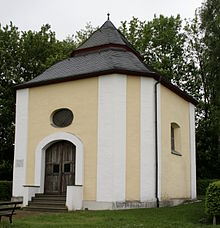Franz Alexander (Nassau-Hadamar)
Franz Alexander von Nassau-Hadamar (born January 27, 1674 in Hadamar ; † May 27, 1711 ibid) was the last prince of Nassau-Hadamar .
Life

Franz Alexander was the son of Moritz Heinrich von Nassau-Hadamar (born April 23, 1626 - † January 24, 1679) and his second wife Maria Leopoldine von Nassau-Siegen (1652–1675). At the age of five he became Prince of Nassau-Hadamar. His guardian and at the same time regent of Nassau-Hadamar was his uncle Franz Bernhard (born September 21, 1637, † September 15, 1695). In 1710 Franz Alexander was appointed judge at the Imperial Court of Justice in Wetzlar and sworn in on January 28, 1711.
His life ended tragically as a result of a fall from his horse near the Limburger Tor (today's name: Hammelburg) in Hadamar. His body was buried in the robe of the Reich Chamberlain in the princely crypt under the Hadamar Franciscan Church on Mönchsberg; his heart, however, found its final resting place - like that of his uncle Franz Bernhard 16 years earlier - in the Marienkapelle on the Herzenberg.
A memorial cross was erected at the site of the fatal accident with the inscription:
I FORGET YOUR - FORGET O GOD MY FAFZNH ANNO 1711 D. 26. MAY.
(FAFZNH = Franz Alexander Prince of Nassau-Hadamar)
The cross was moved later and can be found today around 300 m further southeast on the outskirts of Hadamar, but still on the old path that led from Hadamar to Limburg at the time.
Marriage and offspring
On October 18, 1695 Franz Alexander married in Lovosice (Bohemia) Elisabeth Katharina Felicitas von Hessen-Rheinfels-Rotenburg (born February 14, 1677 at Rheinfels Castle near St. Goar ; † May 15, 1739 in Diez , buried in the Franciscan convent of St. Martin near Boppard ), the daughter of Wilhelm the Elder of Hesse-Rheinfels-Rotenburg . The couple had the following children:
- Franziska Maria Anna Wilhelmina (born September 16, 1696 - † June 18, 1697)
- Elisabeth (born September 21, 1698; † October 2, 1724 in Roermond ), later a nun in Thorn and Essen
- Joseph Hugo (April 18, 1701 - December 6, 1708)
- Charlotte Wilhelmine (born September 21, 1703; † September 25, 1740) ∞ on September 29, 1721 Jean Philippe Eugène de Merode-Westerloo (1674-1732); Prince Albert-Henri von Merode, who was born in Brussels on September 8, 1975 and married Countess Marie Christine von Soden-Fraunhofen on July 20, 2003 in Alt-Fraunhofen, comes from this line.
In 1705 the spouses separated. Probably Ernestine, the princess's sister, had caused the increasing tension between the two. But even after Ernestine had entered the Altenberg monastery near Wetzlar, the couple could not find each other despite attempts by Johann Hugo von Orsbeck , Wetzlar chamber judge and Trier prince-bishop, as well as Emperor Joseph I. From then on, his wife, Princess Elisabeth, lived mostly in Mengerskirchen Castle, separated from the children . Another attempt at reconciliation with Franz Alexander on October 23, 1708 in Hadamar failed. Only the death of their son and hereditary prince Joseph Hugo brought them together again in Hadamar.
When Franz Alexander died in May 1711, he left no male descendants, and so the Nassau-Hadamar line of princes became extinct. After long negotiations, the principality fell to the Nassau agnates , the male regents of Nassau-Diez, Nassau-Dillenburg, Nassau-Siegen (Catholic line) and Nassau-Siegen (Reformed line) in 1717 . Emperor Charles VI. gave his approval to this regulation only in 1728. In the course of this division of the estate, the city of Hadamar came to the house of Nassau-Siegen (Catholic line).
At the front of the crypt of the Hadamar princes under the former Franciscan church on the Aegidienberg is a painting that shows the prince kneeling and praying to the crucified Jesus with his family. Red crosses are painted over the heads of the deceased - Franz Alexander, Joseph Hugo and Franziska Wilhelmina. Franz Alexander wears metal armor; next to him lies a crown adorned with pearls and a shimmering golden cross.
Franz Alexander's widow Elisabeth Katharina Felicitas married Count Anton Ferdinand von Attems , who was almost 14 years younger and also widowed, in Nuremberg on September 6, 1727 . He had lived with his first wife Marie Auguste Freiin von Ow zu Hirrlingen at Schloss Sterneck .
Elisabeth Katharina Felicitas died at the age of 62 on May 15, 1739 in Diez an der Lahn.
Buildings
Franz Alexander had a number of impressive building projects carried out in Hadamar and the surrounding area. In addition to the stucco decoration of Hadamar Castle , three chapels were built:
- 1699 the Hoheholzkapelle west of Hadamar
- 1702 the Nothelferkapelle in the district Steinbach , originally built as Marienkapelle
- 1706 the Kreuzkapelle in the Niederzeuzheim district
Web links
Individual evidence
- Karl Josef Stahl, Hadamar - City and Castle , 1974
- Walter Michel, Das Herz des Fürsten Johann Ludwig von Nassau-Hadamar found , in: Nassauische Annalen 76, 1965, p. 226
| predecessor | Office | successor |
|---|---|---|
| Moritz Heinrich |
Prince of Nassau-Hadamar 1679–1711 |
Friedrich Wilhelm Adolf of Nassau-Siegen |
| personal data | |
|---|---|
| SURNAME | Franz Alexander |
| ALTERNATIVE NAMES | Nassau-Hadamar, Franz Alexander von |
| BRIEF DESCRIPTION | Prince of Nassau-Hadamar |
| DATE OF BIRTH | January 27, 1674 |
| PLACE OF BIRTH | Hadamar |
| DATE OF DEATH | May 27, 1711 |
| Place of death | Hadamar |




